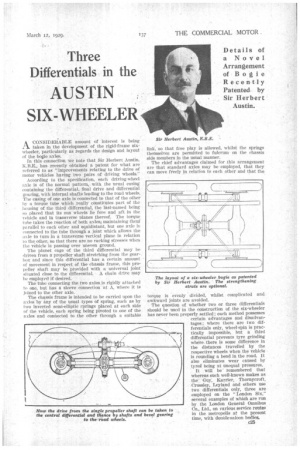Three Differentials in the
Page 55

If you've noticed an error in this article please click here to report it so we can fix it.
AUSTIN SIX-WHEELER
A. CONSIDERABLE amount of interest. is being taken in the development of the rigid-frame six'wheeler, particularly as regards the design and layout of the bogie axles.
In this Connection we note that Sir Herbert Austin, K.B.E„ has recently obtained a patent for what are referred to as "improvements relating to the drive of motor vehicles having two pairs of driving wheels."
According to the specification, each driving-wheel axle is Of the normal pattern, with the usual casing containing the .differential, final drive and differential gearing, with internal shafts leading to the road wheels. The Casing of one axle is connected to that of the other by a torque tube which really constitutes part of the housing of the third differential, the last-named being HO placed that its sun wheels lie fore and aft in the vehicle and in transverse planes thereof. The torque tube takes the reaction of both axles,‘ maintaining thenf parallel to each other and equidistant, but one axle is connected to the tube througha joint which allows the axle to turn In a transverse vertical plane in relation to the other, so that there are no racking stresses when the vehicle is passing over uneven ground.
The planet cage of the third differential may be driven from a propeller shaft stretching from the gear-. box and since this differential has a certain amount of movement in respect of the chassis frame, this propeller shaft may be provided with a universal joint situated close to the differential. A chain drive may be employed if desired.
The tube connecting the two axles is rigidly attached to one, but has a sleeve connection at A, where it is joined to the other axle.
The chassis frame is intended to be carried upon the axles by any of the usual types 'Of spring, such as by twO inverted semi-elliptic springs placed at each side of the vehicle, each spring being pivoted to one of the axles and connected to the other through a suitable link, so that free play is allowed, whilst the springs themselves are permitted to fulcrum on the chassis side members in the usual manner.
The chief advantages claimed for this arrangement are that standard axles may be employed, that they can move Neely in, relation to each .other 'and that the torque is evenly divided, whilst complicated and awkward joints are avoided.
The question of whether two or three differentials should be used in the construction of the six-wheeler has never been, properly settled ; each method possesses certain advantages and disadvani---tages ; where there are two dif ferentials only, wheel-spin is practically impossible, but a third differential prevents tyre grinding where-there is some difference in the distances travelled by the respective wheels when the vehicle is rounding a bend in the road. It also eliminates wear caused by tyre being at unequal pressures.
It will be remembered that whereas such well-known makes as the Guy, Karrier, Thornycroft, Crossley, Leyland and others use two differentials only, three are employed on the "London Six," several examples of which are run by the London General Omnibus Co., Ltd., on various service routes in the metropolis at the present time, with double-saloon bodies.




























































































































